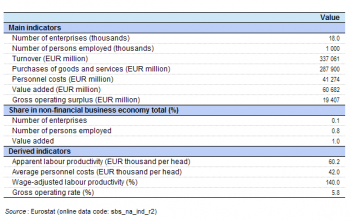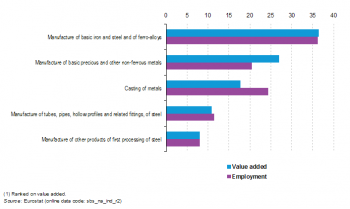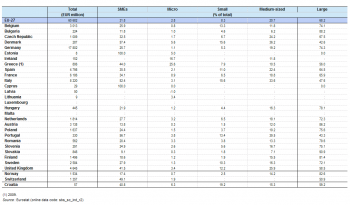Archive:Manufacture of basic metals statistics - NACE Rev. 2
This Statistics Explained article is outdated and has been archived - for recent articles on structural business statistics see here.
- Data from April 2013. Most recent data: Further Eurostat information, Main tables and Database.
This article presents an overview of statistics for basic metals manufacturing in the European Union (EU), as covered by NACE Rev. 2 Division 24.


(% share of sectoral total) - Source: Eurostat (sbs_na_ind_r2)







(% share of sectoral total) - Source: Eurostat (sbs_sc_ind_r2)


Main statistical findings
Structural profile
The 18.0 thousand enterprises in the EU-27‘s basic metals manufacturing sector (Division 24) in 2010 made up 0.1 % of all enterprises in the non-financial business economy (Sections B to J and L to N and Division 95). However, in terms of employment this sector was far more significant, as 1.0 million persons worked in basic metals manufacturing across the EU in 2010, equivalent to 0.8 % of the non-financial business economy workforce and 3.3 % of manufacturing (Section C) employment. In 2010, EUR 60.7 billion of value added was generated through basic metals manufacturing in the EU-27, around 1.0 % of the non-financial business economy total and 3.8 % of the manufacturing total.
The apparent labour productivity of the EU-27’s basic metals manufacturing sector in 2010 was EUR 60.2 thousand per person employed, above the manufacturing average of EUR 52.8 thousand per person employed. Equally, average personnel costs within this sector were above the manufacturing average, reaching EUR 42.0 thousand per employee for the EU-27’s basic metals manufacturing sector in 2010 which was EUR 6.2 thousand per employee higher than the manufacturing average. The combination of these two indicators produces the wage-adjusted labour productivity ratio which stood at 140.0 % for the EU-27’s machinery and equipment manufacturing sector in 2010, some 4.8 percentage points below the non-financial business economy average (144.8 %) and further still below the manufacturing average (148.0 %).
The gross operating rate (the relation between the gross operating surplus and turnover) was 5.8 % in 2010 for the EU-27’s basic metals manufacturing sector, lower than the manufacturing (9.0 %) and non-financial business economy (10.1 %) averages.
Sectoral analysis
Within the EU-27’s basic metals manufacturing sector the three largest subsectors in terms of employment were the manufacture of basic iron and steel and of ferro-alloys (Group 24.1), the casting of metals (Group 24.5) subsector, and the manufacture of basic precious and other non-ferrous metals (Group 24.4), occupying around one third, one quarter and one fifth respectively of the basic metals manufacturing workforce in 2010. In output terms, the ranking of the second and third largest subsectors was reversed, indicating relatively high apparent labour productivity for the manufacture of basic precious and other non-ferrous metals subsector and relatively low apparent labour productivity for the casting of metals.
In 2010, the only subsector within the basic metals manufacturing sector to record an apparent labour productivity figure below the non-financial business economy (EUR 44.8 thousand per person employed) and manufacturing (EUR 52.8 thousand per person employed) averages was the casting of metals, where value added per person employed averaged EUR 44.2 thousand across the EU-27. The highest level of apparent labour productivity was EUR 80.2 thousand recorded for the manufacture of basic precious and other non-ferrous metals.
At the NACE group level, personnel costs per employee peaked in 2010 at an average of EUR 48.2 thousand for the EU-27’s manufacture of basic precious and other non-ferrous metals subsector. Average personnel costs per employee exceeded the non-financial business economy average (EUR 30.9 thousand) for all basic metals manufacturing subsectors and also exceeded the manufacturing average (EUR 35.8 thousand) for all subsectors except for the casting of metals.
The wage-adjusted labour productivity ratio for three of the EU-27’s manufacture of basic metals subsectors was below the non-financial business economy and manufacturing averages: these were the casting of metals, the manufacture of basic iron and steel and of ferro-alloys, and the manufacture of steel tubes, pipes, profiles and fittings (Group 24.2). The remaining subsectors reported wage-adjusted labour productivity ratios of 150.0 % for the manufacture of other products of first processing of steel (Group 24.3) and 166.3 % for manufacture of basic precious and other non-ferrous metals.
For all five of the basic metals manufacturing subsectors, EU-27 gross operating rates were below the non-financial business economy (10.1 %) and manufacturing (9.0 %) averages. This ratio ranged, in 2010, from 4.3 % for the manufacture of basic iron and steel and of ferro-alloys (the second lowest gross operating rate among all manufacturing NACE groups) to 7.6 % for the manufacture of steel tubes, pipes, profiles and fittings.
Country analysis
Germany had the highest value added of any EU Member State in each of the basic metals manufacturing subsectors in 2010: Germany’s share of EU-27 value added ranged from 25.9 % for the manufacture of basic precious and other non-ferrous metals to 38.7 % for the casting of metals. Slovakia’s contribution to EU-27 value added in this sector was 1.4 %, and this was Slovakia’s second highest share among all of the NACE divisions within the non-financial business economy; Austria’s 5.2 % share was its third highest share.
Unsurprisingly, the relative importance of the basic metals manufacturing sector in 2010 was highest in Slovakia and Austria. This sector accounted for 2.7 % of non-financial business economy value added in Slovakia and 2.1 % in Austria: the next highest share was 1.8 % in Finland. Austria and Finland were particularly highly specialised in the manufacture of basic iron and steel and of ferro-alloys.
The wage-adjusted labour productivity ratios available for most of the EU Member States for 2010 reflect the recovery from the weak economic situation in the previous year: all of the Member States recorded wage-adjusted labour productivity ratios in excess of 100 %, whereas 11 of them failed to pass this threshold in 2009. Nevertheless, wage-adjusted labour productivity ratios for basic metals manufacturing remained below the manufacturing average for 13 of the Member States in 2010. The highest wage-adjusted labour productivity ratio was 268.6 % in Cyprus, whereas the lowest ratios were recorded in Lithuania (104.0 %) and Sweden (104.5 %). Croatia recorded a wage-adjusted labour productivity ratio of 73.4 %, indicating that average personnel costs exceeded apparent labour productivity per person employed.
A broadly similar situation was observed for the gross operating rate, where Cyprus recorded by far the highest gross operating rate in the basic metals manufacturing sector among those EU Member States for which data are available. The gross operating rate in Cyprus was 25.2 % in 2010, while the rate in Lithuania was just 0.5 %. Apart from these two extreme values the rates in the remaining Member States ranged from 3.9 % for the Czech Republic to 10.5 % for Austria.
Size class analysis
Large enterprises (employing 250 or more persons) contributed 68.2 % of the EU-27’s basic metals manufacturing value added in 2010, which was above the non-financial business economy (42.3 %) and manufacturing (55.5 %) averages. In a similar vein, large enterprises employed 65.1 % of the EU-27’s basic metals manufacturing workforce, which was even further above the share of large enterprises in the non-financial business economy (32.5 %) and manufacturing (40.0 %) workforces. The employment shares of micro enterprises (employing fewer than 10 persons) and small enterprises (employing 10 to 49 persons) were particularly low for the basic metals manufacturing sector, employing 4.5 % and 8.3 % of the workforce respectively, less than half the manufacturing average (14.3 %).
In the vast majority of EU Member States, as well as in Croatia and Switzerland, large enterprises were responsible for more than half of the value added generated in the basic metals manufacturing sector in 2010, with the share exceeding four fifths in Finland, Austria and Bulgaria, and peaking at 90.9 % in Slovakia. In Italy, Portugal and Denmark the contribution of large enterprises to total value added was less than half, but the relative importance of large enterprises remained more than for any of the three other size classes shown in Table 6b. In Estonia and Cyprus there were no large enterprises in the basic metals manufacturing sector in 2010 and value added was concentrated among medium-sized enterprises (employing 50 to 249 persons) and small enterprises.
Data sources and availability
The analysis presented in this article is based on the main dataset for structural business statistics (SBS) and size class data, all of which are published annually.
The main series provides information for each EU Member State as well as a number of non-member countries at a detailed level according to the activity classification NACE. Data are available for a wide range of variables.
In structural business statistics, size classes are generally defined by the number of persons employed. A limited set of the standard structural business statistics variables (for example, the number of enterprises, turnover, persons employed and value added) are analysed by size class, mostly down to the three-digit (group) level of NACE. The main size classes used in this article for presenting the results are:
- small and medium-sized enterprises (SMEs): with 1 to 249 persons employed, further divided into;
- micro enterprises: with less than 10 persons employed;
- small enterprises: with 10 to 49 persons employed;
- medium-sized enterprises: with 50 to 249 persons employed;
- large enterprises: with 250 or more persons employed.
Context
This article presents an overview of statistics for the basic metals manufacturing sector in the EU, as covered by NACE Rev. 2 Division 24. This division includes the activities of smelting and/or refining ferrous and non-ferrous metals from ore, pig or scrap, using electrometallurgic and other process metallurgic techniques.
This division also includes the manufacture of metal alloys and super-alloys by introducing other chemical elements to pure metals.
The output of smelting and refining, usually in ingot form, is used in rolling, drawing and extruding operations to make products such as plate, sheet, strip, bars, rods, wire or tubes, pipes and hollow profiles and in molten form to make castings and other basic metal products.
The manufacture of other products from the first processing of steel (such as bars, strips, sheets or wire) includes manufacturing by cold processing of steel. The manufacture of basic precious and non-ferrous metals includes gold, silver, platinum, aluminium, lead, zinc, tin, copper, chrome, manganese, nickel, nuclear fuel (uranium).
This NACE division is composed of five groups:
- the manufacture of basic iron and steel and of ferro-alloys (Group 24.1);
- the manufacture of tubes, pipes, hollow profiles and related fittings, of steel (Group 24.2);
- the manufacture of other products of first processing of steel (Group 24.3);
- the manufacture of basic precious and non-ferrous metals (Group 24.4);
- the casting of metals (Group 24.5) as semi-finished products.
Excluded are the manufacture of finished metal products (which from part of the manufacture of fabricated metal products, Division 25) and metal jewellery (which is classified as part of other manufacturing, Division 32).
See also
- Other analyses of the business economy by NACE Rev. 2 sector
- Manufacturing
- Structural business statistics introduced
Further Eurostat information
Publications
- European business - facts and figures (online publication)
- Key figures on European Business – with a special feature section on SMEs – 2011 edition
Main tables
Database
- SBS - industry and construction (sbs_ind_co)
- Annual detailed enterprise statistics - industry and construction (sbs_na_ind)
- Annual detailed enterprise statistics for industry (NACE Rev. 2 B-E) (sbs_na_ind_r2)
- SMEs - Annual statistics by size class - industry and construction (sbs_sc_ind)
- Industry by employment size class (NACE Rev. 2 B-E) (sbs_sc_ind_r2)
- Annual detailed enterprise statistics - industry and construction (sbs_na_ind)
- SBS - regional data - all activities (sbs_r)
- SBS data by NUTS 2 regions and NACE Rev. 2 (from 2008 onwards) (sbs_r_nuts06_r2)
Dedicated section
Source data for tables and figures (MS Excel)
Other information
- Decision 1578/2007/EC of 11 December 2007 on the Community Statistical Programme 2008 to 2012
- Regulation 295/2008 of 11 March 2008 concerning structural business statistics